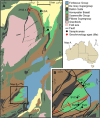Paleomagnetic evidence for modern-like plate motion velocities at 3.2 Ga
- PMID: 32494654
- PMCID: PMC7176424
- DOI: 10.1126/sciadv.aaz8670
Paleomagnetic evidence for modern-like plate motion velocities at 3.2 Ga
Abstract
The mode and rates of tectonic processes and lithospheric growth during the Archean [4.0 to 2.5 billion years (Ga) ago] are subjects of considerable debate. Paleomagnetism may contribute to the discussion by quantifying past plate velocities. We report a paleomagnetic pole for the ~3180 million year (Ma) old Honeyeater Basalt of the East Pilbara Craton, Western Australia, supported by a positive fold test and micromagnetic imaging. Comparison of the 44°±15° Honeyeater Basalt paleolatitude with previously reported paleolatitudes requires that the average latitudinal drift rate of the East Pilbara was ≥2.5 cm/year during the ~170 Ma preceding 3180 Ma ago, a velocity comparable with those of modern plates. This result is the earliest unambiguous evidence yet uncovered for long-range lithospheric motion. Assuming this motion is due primarily to plate motion instead of true polar wander, the result is consistent with uniformitarian or episodic tectonic processes in place by 3.2 Ga ago.
Copyright © 2020 The Authors, some rights reserved; exclusive licensee American Association for the Advancement of Science. No claim to original U.S. Government Works. Distributed under a Creative Commons Attribution NonCommercial License 4.0 (CC BY-NC).
Figures





Similar articles
-
Plate motion and a dipolar geomagnetic field at 3.25 Ga.Proc Natl Acad Sci U S A. 2022 Nov;119(44):e2210258119. doi: 10.1073/pnas.2210258119. Epub 2022 Oct 24. Proc Natl Acad Sci U S A. 2022. PMID: 36279430 Free PMC article.
-
Paleomagnetic evidence for Neoarchean plate mobilism.Nat Commun. 2024 Dec 30;15(1):10814. doi: 10.1038/s41467-024-55117-w. Nat Commun. 2024. PMID: 39737974 Free PMC article.
-
A Paleolatitude Calculator for Paleoclimate Studies.PLoS One. 2015 Jun 10;10(6):e0126946. doi: 10.1371/journal.pone.0126946. eCollection 2015. PLoS One. 2015. PMID: 26061262 Free PMC article.
-
When crust comes of age: on the chemical evolution of Archaean, felsic continental crust by crustal drip tectonics.Philos Trans A Math Phys Eng Sci. 2018 Oct 1;376(2132):20180103. doi: 10.1098/rsta.2018.0103. Philos Trans A Math Phys Eng Sci. 2018. PMID: 30275165 Free PMC article. Review.
-
Archean microfossils: a reappraisal of early life on Earth.Res Microbiol. 2003 Nov;154(9):611-7. doi: 10.1016/j.resmic.2003.08.006. Res Microbiol. 2003. PMID: 14596897 Review.
Cited by
-
Alpine-style nappes thrust over ancient North China continental margin demonstrate large Archean horizontal plate motions.Nat Commun. 2021 Oct 26;12(1):6172. doi: 10.1038/s41467-021-26474-7. Nat Commun. 2021. PMID: 34702843 Free PMC article.
-
High geomagnetic field intensity recorded by anorthosite xenoliths requires a strongly powered late Mesoproterozoic geodynamo.Proc Natl Acad Sci U S A. 2022 Jul 19;119(29):e2202875119. doi: 10.1073/pnas.2202875119. Epub 2022 Jul 11. Proc Natl Acad Sci U S A. 2022. PMID: 35858328 Free PMC article.
-
Plate motion and a dipolar geomagnetic field at 3.25 Ga.Proc Natl Acad Sci U S A. 2022 Nov;119(44):e2210258119. doi: 10.1073/pnas.2210258119. Epub 2022 Oct 24. Proc Natl Acad Sci U S A. 2022. PMID: 36279430 Free PMC article.
-
Coupled fates of Earth's mantle and core: Early sluggish-lid tectonics and a long-lived geodynamo.Sci Adv. 2024 Aug 2;10(31):eadp1991. doi: 10.1126/sciadv.adp1991. Epub 2024 Aug 2. Sci Adv. 2024. PMID: 39093968 Free PMC article.
-
Nanoscale imaging of Fe-rich inclusions in single-crystal zircon using X-ray ptycho-tomography.Sci Rep. 2024 Mar 1;14(1):5139. doi: 10.1038/s41598-024-55846-4. Sci Rep. 2024. PMID: 38429500 Free PMC article.
References
-
- Bleeker W., The late Archean record: A puzzle in ca. 35 pieces. Lithos 71, 99–134 (2003).
-
- Thurston P., Greenstone belts and granite−greenstone terranes: Constraints on the nature of the archean world. Geosci. Can. 42, 10.12789/geocanj.2015.42.081 (2015).
-
- Tang M., Chen K., Rudnick R. L., Archean upper crust transition from mafic to felsic marks the onset of plate tectonics. Science 351, 372–375 (2016). - PubMed
-
- Greber N. D., Dauphas N., Bekker A., Ptáček M. P., Bindeman I. N., Hofmann A., Titanium isotopic evidence for felsic crust and plate tectonics 3.5 billion years ago. Science 357, 1271–1274 (2017). - PubMed
-
- Van Kranendonk M. J., Two types of archean continental crust: Plume and plate tectonics on early earth. Am. J. Sci. 310, 1187–1209 (2010).
LinkOut - more resources
Full Text Sources
Miscellaneous

